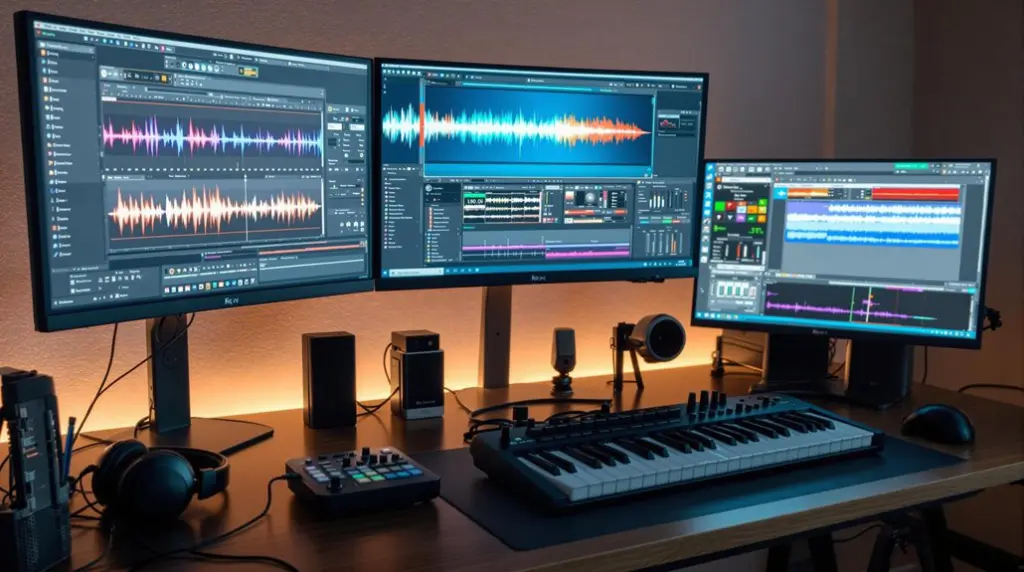The Slate Digital Virtual Tape Machines (VTM) VST Plugin delivers a meticulously crafted emulation of Studer A827 and A80 RC tape recorders, capturing their compression, harmonic distortion, and saturation. Featuring two tape formulations, FG456 and FG9, and adjustable tape speeds of 15 and 30 inches per second, VTM provides tailored sound shaping. Despite its higher CPU usage, the plugin offers dynamic automation for efficiency. Users praise its analog warmth and sound quality, though some find the default settings needing adjustment. Its competitive price and authentic tape emulation position VTM favorably among other market offerings, appealing to both home studios and professionals.
Key Takeaways
- Slate VTM emulates Studer A827 and A80 tape machines, delivering analog warmth and depth.
- Offers FG456 and FG9 tape formulations for vintage warmth and modern punch.
- Minimalistic interface with essential controls and integrated VU meters for ease of use.
- High CPU usage but supports up to 16 instances with dynamic automation.
- Priced competitively at $199, suitable for both home and professional studios.
Overview of Slate VTM
Slate Digital’s Virtual Tape Machines (VTM) plugin stands as a meticulously engineered tool designed to replicate the nuanced sound characteristics of two iconic tape recorders, the Studer A827 and A80 RC. This tape simulation plugin offers a sophisticated approach to imparting the warmth and depth associated with analog tape into digital recordings.
Utilizing advanced algorithms, VTM captures the subtle compression, harmonic distortion, and saturation that are hallmarks of traditional tape recording techniques. It is also essential for achieving a professional sound by transforming raw mixes into polished tracks, as noted in audio mastering.
Key to its functionality are the two tape formulations available: FG456 and FG9. FG456 provides a classic warmth, ideal for adding vintage character to audio tracks, while FG9 offers a more modern, punchy sound, suitable for contemporary music production.
The plugin also supports adjustable tape speeds of 15 and 30 inches per second, allowing for further versatility in sound shaping. These speeds influence the frequency response and dynamic range, giving users control over the tonal qualities and transient response of their recordings.
Additionally, VTM integrates seamlessly with various digital audio workstations (DAWs) through compatibility with VST, AU, and AAX formats, and supports both 32-bit and 64-bit systems on Mac and Windows platforms.
Priced at $199, it remains a highly regarded tool for both tracking and mastering, praised for its ability to enhance audio tracks with depth and character.
User Interface and Controls
The user interface of the Slate Digital Virtual Tape Machines (VTM) is characterized by a minimalistic design that mirrors the classic tape machines, ensuring both aesthetic appeal and ease of use.
Key controls such as Input, Output, Bias, and Speed provide precise adjustments for tailored tape emulation, while integrated VU meters offer visual feedback for accurate monitoring.
Additionally, the grouping feature enhances workflow efficiency by allowing simultaneous adjustments across multiple plugin instances.
The extended settings menu offers advanced options like global calibration and Noise Reduction, adding to the plugin’s flexibility and user experience.
Minimalistic Control Design
Emphasizing a minimalistic approach, the user interface of the Slate Digital Virtual Tape Machines (VTM) VST plugin prioritizes ease of use by featuring only essential controls.
This design philosophy focuses on control simplicity and user accessibility, ensuring that even those new to tape emulation can navigate the plugin with ease. The primary controls consist of tape machine selection, tape speeds (15ips and 30ips), and bias settings, which allow users to tailor audio output with straightforward customization options.
The intuitive layout is further enhanced by the inclusion of VU meters, providing immediate visual feedback on levels without overwhelming users with an array of dials and knobs.
This balance between essential functionality and minimalistic design is critical in maintaining a streamlined user experience.
Additional settings like noise reduction and bass alignment are seamlessly integrated into the interface, offering further customization while keeping the overall design uncluttered.
These controls provide users with the flexibility to fine-tune their sound without sacrificing user accessibility.
Grouping Feature Benefits
Building on the minimalistic control design, the grouping feature in Virtual Tape Machines (VTM) greatly enhances workflow efficiency and consistency when managing multiple plugin instances. The ability to control settings such as Input, Output, Bias, and Speed across all grouped instances means that users can guarantee uniform sound treatment throughout a project, which is vital for maintaining a cohesive mix.
This is particularly beneficial during the mixing and mastering stages, where workflow optimization is necessary. By allowing global adjustments, the grouping feature eliminates the need for repetitive tweaks on individual tracks. This considerably enhances mixing efficiency, as users can save valuable time and focus on other important aspects of the production process.
Additionally, the feature’s capacity for global calibration facilitates precise management of VU ballistics, guaranteeing consistent levels across multiple tracks. This is essential for achieving a balanced mix, where each element sits correctly within the overall soundscape.
The intuitive design of the grouping feature contributes to a user-friendly interface, making it accessible for both novice and experienced producers. This level of ease-of-use, combined with its powerful functionality, underscores VTM’s role in modern digital audio workflows.
Additional Sound Settings
Understanding the additional sound settings in the Slate Digital Virtual Tape Machines (VTM) is essential for harnessing the plugin’s full potential. The user interface, designed with a minimalist approach, guarantees essential controls like Input, Output, Bias, and Speed settings are easily accessible, enhancing usability.
These fundamental parameters are critical for achieving authentic tape saturation and nuanced sound shaping.
For advanced noise control, VTM includes adjustable parameters such as Noise Reduction, WOW & Flutter, and Hiss Automation. These settings offer users precise manipulation of audio characteristics, allowing for a tailored sound experience.
Moreover, the robust VU meters provide visual feedback, important for monitoring levels and dynamics during playback and recording.
The grouping feature is another standout, enabling users to link multiple instances of the plugin for simultaneous adjustments, markedly streamlining the mixing process.
Additionally, the settings menu offers global calibration and VU ballistics customization, allowing users to adapt the plugin to their specific audio requirements.
Key Features:
- Input and Output Controls: For managing signal levels and achieving desired tape saturation.
- Noise Reduction Settings: Advanced noise control for minimizing unwanted artifacts.
- WOW & Flutter and Hiss Automation: Fine-tuning audio characteristics for a polished sound.
- Global Calibration and VU Ballistics: Customizable settings for precise audio monitoring.
Sound Quality
The Slate Digital Virtual Tape Machines VST Plugin excels in bestowing audio tracks with unparalleled depth and character, closely emulating the analog warmth of classic tape recordings.
Notable for its subtle sonic enhancements, the plugin allows for significant improvements in audio quality through fine-tuned adjustments, making it highly effective for both mixing and mastering.
Users particularly appreciate its ability to enhance the presence and roundness of drums, thereby contributing to a more cohesive and polished overall sound.
Depth and Character
A significant aspect of the Slate Digital Virtual Tape Machines (VTM) is its ability to impart depth and character to audio tracks, resulting in a more immersive and engaging listening experience.
This plugin excels in enhancing sound dynamics and enriching audio textures, making it a valuable tool for both individual track processing and stereo bus applications.
- Stereo Bus Processing at 15 i.p.s with FG9 Tape: This setting is particularly effective for adding warmth and smoothness to the overall mix, creating a cohesive sonic landscape that envelops the listener.
- Individual Track Processing at 30 i.p.s with FG456 Tape: Ideal for drums and other key elements, this configuration delivers a full-bodied sound that enhances the presence and impact of individual instruments within the mix.
- Roundness and Presence Enhancement: Users report that VTM adds significant roundness and presence to drums, making them stand out more effectively while contributing to a polished and professional sound.
- Natural Sound Quality Improvements: While the changes made by VTM can be subtle, they are highly effective in naturally elevating the overall sound quality without being overly noticeable, ensuring that tracks retain their original character.
Subtle Sonic Enhancements
When implemented thoughtfully, subtle sonic enhancements with the Slate Digital Virtual Tape Machines (VTM) can considerably boost the overall sound quality of a mix. The VTM plugin excels in adding depth and character, providing nuanced tape saturation that enhances the frequency spectrum. Through small adjustments, users can achieve significant improvements, particularly in the mid-range and bass frequencies, thanks to the FG456 tape formulation’s smooth and rounded sound.
| Tape Formulation | Frequency Characteristics | Recommended Usage |
|---|---|---|
| FG456 | Smooth mid-range, rounded bass | Ideal for adding warmth and character |
| FG9 | Modern, punchy across frequencies | Suitable for dynamic, contemporary sounds |
| 15 ips | Full, cohesive sound | Best for stereo bus processing |
| Subtle Adjustments | Enhanced roundness and presence | Effective for drums and instruments |
Operating at 15 inches per second (ips) on the stereo bus is particularly effective for creating a fuller, more cohesive mix. This setting allows the VTM to fill frequency gaps efficiently, resulting in a “glue” effect that binds elements together harmoniously. The plugin’s capability to produce subtle yet impactful enhancements means it can improve the overall mix quality with minimal effort, making it an indispensable tool for achieving professional-grade results.
Analog Warmth
Building on the foundation of subtle sonic enhancements, exploring the analog warmth offered by the Slate Digital Virtual Tape Machines (VTM) reveals its true potential in elevating audio quality.
The plugin meticulously recreates the quintessential tape saturation and vintage emulation, providing a lush, authentic sound that enhances recordings. Central to this warmth are two distinct tape formulations: FG456, known for its rounded bass and smooth mid-range warmth, and FG9, which delivers a punchier, modern sound across the frequency spectrum.
Key features contributing to this analog warmth include:
- Tape Formulations: FG456 and FG9 offer tailored tonal characteristics, with FG456 emphasizing vintage warmth and FG9 providing a contemporary, punchy feel.
- Tape Speeds: The VTM allows for 15ips and 30ips speeds. The 15ips setting results in a fatter sound with more inherent hiss, while 30ips produces a cleaner, more detailed sound suited for individual tracks.
- Subtle Adjustments: Minor tweaks in the VTM can greatly enhance the depth and character of audio, often described as adding a “glue” effect that cohesively binds mixes.
- Instrument Enhancement: Users report remarkable improvements in the presence and roundness of drums and electric guitars, making them sound fuller and more confident in the mix.
The Slate Digital VTM stands as a pivotal tool for those seeking to infuse their digital recordings with analog warmth.
Technical Considerations
Understanding the technical considerations of Slate Digital Virtual Tape Machines (VTM) is fundamental for leveraging its full potential within a digital audio workstation (DAW). One significant aspect is latency management. VTM can introduce latency, particularly when processing multiple tracks simultaneously. To mitigate this, employing delay compensation within the DAW is highly recommended. This practice guarantees synchronization across all tracks, maintaining the integrity of the mix.
Another important factor is CPU optimization. VTM is known to utilize approximately four times the CPU power compared to competitors like Waves Ampex. Despite its higher CPU usage, VTM’s computational efficiency allows modern machines to handle up to 16 instances effectively. This balance between processing power and performance is essential for maintaining workflow fluidity and preventing system overloads during complex mixing sessions.
Additionally, considering automation techniques can help optimize CPU usage by dynamically adjusting parameters during different parts of the track, thereby enhancing performance.
Compatibility also plays a significant role. VTM supports VST, RTAS, and AU formats, with AAX coding in development, making it versatile across various DAWs. This broad usability guarantees that users can integrate VTM into their existing setups without compatibility concerns.
Comparison to Other Plugins
Having examined the technical considerations of Slate Digital Virtual Tape Machines (VTM), it is pertinent to compare VTM to other prominent tape emulation plugins in the market. VTM distinguishes itself through several notable advantages, particularly when analyzed alongside its competitors.
1. Authenticity and Subtle Enhancements: VTM is often lauded for its ability to subtly enhance audio while maintaining authenticity. Unlike the UAD Studer A800, which offers deeper control but necessitates specific hardware, VTM achieves a remarkable balance without requiring additional investments.
2. Natural Sound Preservation: Compared to Waves MPX, which is known for its more obvious tape effect, VTM focuses on preserving the natural essence of the audio. This makes it particularly appealing to users who seek a tape effect that adds warmth and depth without excessive coloration.
3. User-Friendly Design: VTM’s minimalistic interface stands in contrast to other plugins that might overwhelm users with numerous dials and settings. Despite its simplicity, it does not compromise on versatility, making it suitable for both novice and experienced users.
This ease of use guarantees that even beginners can achieve enhanced sound quality and professional results.
4. Sonic Signature: Users frequently commend VTM for its unique ability to breathe life into audio tracks. This distinctive sonic signature sets it apart from alternatives like Magnetic and Reel Tape Suite, positioning VTM as a preferred choice for many.
User Experiences
User experiences with Slate Digital Virtual Tape Machines (VTM) frequently underscore its ability to add warmth and character to recordings, a feature that is particularly valued for its effectiveness in taming harsh frequencies and enhancing the overall mix quality.
Many users have highlighted this VST plugin’s role in achieving a fuller, more cohesive sound, especially on vital tracks such as drums and bass. This positive user feedback underscores VTM’s capability to enrich the sonic texture of recordings.
Moreover, users have found that pairing the VTM with targeted EQ adjustments can further refine the audio quality, making sure that each track sits perfectly in the mix.
However, some users have expressed dissatisfaction with the default settings, specifically pointing out the excessive bass boost, which can sometimes overshadow the desired audio characteristics.
Consequently, these users have shown a preference for alternative plugins like HEAT and PHOENIX for specific applications. In addition, there is a consensus in the community that normalizing levels during evaluations is essential, as automatic volume boosts within the plugin can lead to misleading initial impressions.
Ultimately, user feedback emphasizes the importance of personal plugin preferences and the necessity for individual experimentation.
Users are encouraged to trust their ears and explore various tools to achieve the best sound for their specific needs. This nuanced approach guarantees that the plugin selection process aligns with the unique requirements of each project.
Market Position and Pricing
Slate Digital’s Virtual Tape Machines (VTM) stands out in the competitive landscape of tape emulation plugins, offering a robust set of features at a price point of $199. This positions VTM strategically within the market, balancing affordability and high-quality performance.
A closer competitor analysis reveals that VTM competes closely with offerings from UAD and Waves, both known for their sophisticated tape emulation capabilities. However, VTM distinguishes itself through its user-friendly interface and subtle enhancements in sound quality, which are highly appealing to both home and professional studios.
Additionally, VTM’s high-quality virtual instruments and advanced editing capabilities guarantee it meets the needs of modern producers. Integration with various effects and mixing tools further enhances its utility.
Key factors influencing VTM’s market position include:
- Compatibility and Flexibility: VTM supports Mac and PC systems, alongside various plugin formats such as VST, AU, and AAX, guaranteeing broad usability across different digital audio workstations (DAWs).
- High-Quality Sound Emulation: The plugin captures the warmth and character of analog tape, a critical feature for users aiming to replicate vintage tape machine sonics.
- Pricing Strategy: At $199, VTM offers a competitive price point that undercuts some premium alternatives while delivering comparable, if not superior, sound quality.
- Growing Market Demand: With the increasing demand for authentic tape emulation plugins, VTM is well-positioned to capitalize on this trend with its robust feature set and appealing price.
Frequently Asked Questions
Does Slate Digital Have Free Plugins?
Slate Digital does not offer free plugins. Their premium audio software solutions, such as the Virtual Tape Machines, emphasize Slate advantages and plugin compatibility, with occasional promotions or free trials available through their newsletter for potential discounts.
How Do I Download Slate Digital Plugins?
To download Slate Digital plugins, create an account on their website, navigate to the desired product page, and complete the purchase. Follow the installation process, ensuring software compatibility and authorization via iLok License Manager.
What Does a Tape Machine VST Do?
A Tape Machine VST emulates analog tape characteristics, adding tape saturation and warmth to digital tracks. It offers detailed controls for bias, noise reduction, and modulation, effectively enhancing audio with authentic analog emulation and subtle compression.
What Does Virtual Tape Machine Do?
A virtual tape machine emulates the characteristics of analog tape recording, imparting analog warmth and sound saturation. It enhances audio tracks by simulating tape artifacts, altering bias settings, and optimizing tape speed for desired tonal qualities.
Conclusion
The Slate Digital Virtual Tape Machines (VTM) VST plugin provides an extensive emulation of analog tape recording, featuring a user-friendly interface and high-quality sound reproduction. Its technical robustness and competitive pricing position it favorably in the market. Comparative analysis with other plugins reveals its superior fidelity and versatility. User feedback corroborates its effectiveness in enhancing audio warmth and depth, making it a valuable tool for professionals seeking authentic tape sound emulation.




